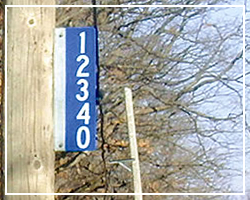Section 6. Maintaining Communication
| Site: | Extension Foundation Online Campus |
| Course: | Farm Security |
| Book: | Section 6. Maintaining Communication |
| Printed by: | Guest user |
| Date: | Friday, January 2, 2026, 12:03 AM |
Description
Staying informed and able to communicate with first responders  and others in an emergency will help protect the health and safety of your family and farm. Have a battery-powered and/or hand-cranked radio, as well as a flashlight, and extra fresh batteries, available for use in case of power failure. A land-line telephone that does not require electricity should be accessible, as well as a cell phone. Keep backup batteries or a crank charging system for cell phones on-hand, or have a car charger that can draw from the vehicle's battery. Remember to rotate your backup stock of batteries regularly, to be sure they will work when you need them. |
Communication
| Often overlooked is the communication loop during an emergency event. It is critical that everyone on the operation knows the chain of command in an emergency; where to check for local weather conditions; who to contact if suspicious activity is noticed; and how to notify employees or their families in an emergency. This is what we will be taking a closer look at in section 6. Staying informed and able to communicate with first responders  and others in an emergency will help protect the health and safety of your family and farm. Have a battery-powered and/or hand-cranked radio, as well as a flashlight, and extra fresh batteries, available for use in case of power failure. A land-line telephone that does not require electricity should be accessible, as well as a cell phone. Keep backup batteries, a portable power bank, or a crank charging system for cell phones on-hand, or have a car charger that can draw from the vehicle's battery. Remember to rotate your backup stock of batteries regularly, to be sure they will work when you need them. |
Stay Informed
Consider purchasing a weather radio, a special radio receiver  or scanner capable of picking up the signal from NOAA Weather Radio All Hazards (NWR). NWR is a nationwide network of radio stations broadcasting continuous weather information directly from the nearest National Weather Service office.NWR broadcasts official Weather Service warnings, watches, forecasts and other hazard information 24 hours a day, 7 days a week. Keep backup batteries for the radio. Provided as a public service by the National Oceanic and Atmospheric Administration (NOAA), part of the Department of Commerce, NWR includes 1000 transmitters, covering all 50 states, adjacent coastal waters, Puerto Rico, the U.S. Virgin Islands, and the U.S. Pacific Territories. Once again, have a battery-powered and/or hand-cranked radio, as well as a flashlight and extra fresh batteries, available for use in case of power failure. |
Access to Emergency Information
 Do employees and family members know where emergency telephone numbers are located? Include emergency contact numbers for yourself as well as neighbors or employees who might assist emergency responders if the need arises. Do employees and family members know how to report an emergency on landline phones or cell phones? A basic set of instructions/information should be posted next to the emergency contact numbers so that employees and family members know how to report an emergency on a landline or a cell phone. These instructions should include the official street address of the farm, the location of the nearest farm map, or the name of the business or farmer the farm map is filed under at the local emergency responders' office. Post a list of emergency telephone numbers near every telephone in a language understood by all personnel. This list should include all emergency personnel, animal and environmental agencies, and help networks. |
Emergency Communication
There should be a list of emergency telephone numbers posted  in a clearly visible location near every telephone, in a language understood by all personnel. This list should include all farm personnel, emergency personnel, animal and environmental agencies, and help networks. All employees and family members should know where emergency telephone numbers are located. Be sure to add emergency contact numbers, both cell and landlines, for all personnel, family members and employees, as well as neighbors, friends and relatives who might assist emergency responders. Each person should also carry a wallet card with this information. Include a long-distance contact number, if possible. In major disasters, local lines and towers may be busy or out of service, but cell phones might be able to reach long distance numbers. Train all employees and family members to properly report an emergency on landline phones and/or cell phones. Provide a basic set of instructions and information posted with the emergency contact numbers, including the farm name, the official street address of the farm, clear directions to the farm location, the owner's name and the farm map. Designate an assembly point where your family and employees know to meet in the event of an emergency. This is crucial to confirming that everyone is accounted for as an emergency unfolds. |